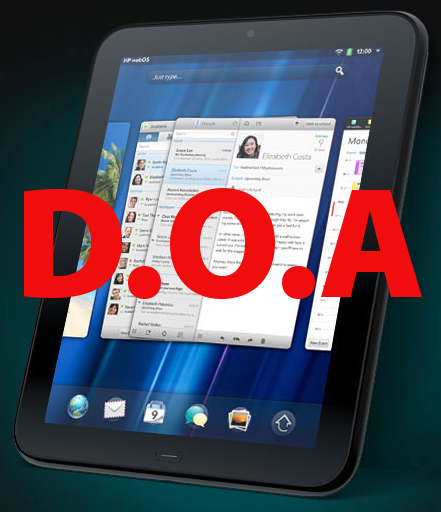HP's TouchPad: Dead on Arrival


At $499, HP's highly-anticipated TouchPad isn't going to get many takers.
My Mobile News colleague James Kendrick reports that the HP TouchPad, which is going on sale next month with several major retail partners, is the "Last Stand" for iPad competitors.
I'm right there with James' excellent analysis, but unfortunately I have to disagree with the "Last Stand" part. To have a Last Stand, you have to be packing heat. By pricing the entry-level TouchPad at $499, HP is just walking out into the gunfight buck-naked with "Shoot me now" painted on its chest.
Also Read: HP TouchPad, Last Stand for iPad Competitors?
The only way the iOS tablet ecosystem can be disrupted by a competitor is to come in substantially cheaper. I've said this as well about Android tablets -- without a comparable ecosystem, you have to come in as more value-priced.
With nearly identical on-paper specifications as the iPad 2, and launching at the same price, HP isn't doing itself any favors. There is absolutely nothing this product has that could be considered an advantage -- not its display, its CPU, nor its front-facing video conferencing camera (which, by the way, is one less than the iPad 2, which also includes a rear camera).
Oh and by the way, it's heavier and thicker than the iPad 2. It also appears to have a bigger battery. Does that mean that the TouchPad has longer battery life or its design is more inefficient? That remains to be seen.
Look, I'm not saying WebOS doesn't appear to be extremely nice from a pure user experience perspective. It's a gorgeous-looking OS that has a great multitasking UI. It also appears to have some advantages in that in utilizing existing web standards for its APIs, developers might be able to get some apps off the ground fairly rapidly.
The problem is, HP is about 65,000 tablet apps short of its largest competitor (300,000 if you count the entire iOS ecosystem) and it's got the chutzpah to sell their product without any key differentiators for the same amount of money.
What does that spell? Dead on Arrival.
Here's what I would do if I was HP. Ready for it? Sell it cheaper. A LOT cheaper.
There are a bunch of folks -- a large amount of folks -- that have not jumped into the tablet world yet because they just don't have $450+ to burn on a tablet, whether it's an iPad 2 or a half-assed Android Honeycomb 3.x-based competitor.
These folks want something cheaper. It's a huge untapped market that Apple and even its Taiwanese, Korean and Chinese frenemies are going to find difficulty reaching, at least for the time being.
Here's the problem -- The BOM on something like the iPad 2 is estimated to be around $325, according to research firm iSuppli.
That's a conservative estimate, since Apple is known to be very adept at managing supply chain costs and purchases a lot of its own inventory up front, so it's probably getting better discounts on consumer electronics components than most if not all of its competitors.
However, let's just say for the sake of argument that the HP TouchPad costs somewhere between $280 and $310 to produce.
I'm reducing manufacturing costs because I'm assuming it's a less difficult device to manufacture than iPad 2, and HP won't have a problem getting components out of Asia that Apple hasn't otherwise cornered the market on.
If the BOM is around $300, then HP doesn't have a lot of leeway on pricing. Getting it out into the channel at $350 would allow HP to get its name out there, and secure a decent amount of market share, but they wouldn't make a ton of money on the devices.
They'd have to get it on the back-end with their app ecosystem, or have some value-added integration with other HP products or compelling Cloud service to go with it.
Honestly, what I'd be really thinking about doing now is getting a 7" version of the device out, and quickly. And pricing it so that it would be a knockout blow to RIM's PlayBook and a large portion of the Android tablet wannabes: $299.
A 7", cheaper TouchPad would do a number of things. First, it would add a key market differentiator to iPad and the Honeycombs, which are larger devices.
Second, it would take away any of the perceived advantages with RIM's PlayBook, as it would have comparable performance, it would cost less, and HP would be able to truly market it as the "Executive" iPad, which the PlayBook was supposed to be.
And unlike RIM's tablet, it wouldn't have the PlayBook's BlackBerry handset co-dependency issues.
In addition to releasing a cheaper TouchPad, I would also corner the market on productivity apps for Tablets. This week, I learned that QuickOffice will be releasing a port to WebOS around the TouchPad's launch time.
If HP purchased QuickOffice, it could kill the iOS and Android versions (a product which has been preloaded on over 30 million Android handsets) and keep the technology to itself, much like RIM did with DataViz's Docs to Go.
[Note: Docs to Go still ships on other platforms besides PlayBook, but it's my guess that all of the development is currently being poured into QNX right now.]
Of course, HP won't do any of these things, because it makes too much sense. I expect the TouchPad to hit the market like a lead balloon. If the HP TouchPad is the "Last Stand" for iPad competitors, I fear that it is more likely to be a Last Whimper.
Is HP's TouchPad going to be Dead on Arrival? Talk Back and Let Me Know.
See related coverage: